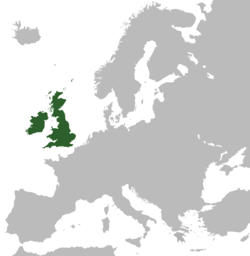Commonwealth of England
historic republic on the British Isles (1649–1660)
(Redirected from Commonwealth of England, Scotland and Ireland)
The Commonwealth of England was the republican government which ruled first England and then Ireland and Scotland from 1649 to 1660. After the execution of Charles I on January 30, 1649, the Commonwealth was declared (An Act declaring England to be a Commonwealth) by the Rump Parliament on May 19, 1649. The government during 1653 to 1659 is properly called The Protectorate, and took the form of direct personal rule by Oliver Cromwell and, after his death, his son Richard, as Lord Protector. The term Commonwealth is, however, loosely used to describe the system of government during the whole of 1649 to 1660, the years of the English Interregnum.
Commonwealth of England | |||||||||||||||||
|---|---|---|---|---|---|---|---|---|---|---|---|---|---|---|---|---|---|
| 1649–1660 | |||||||||||||||||
Top: Flag of the Commonwealth
Bottom: The banner of the republic in the style of the flag of King James I | |||||||||||||||||
 | |||||||||||||||||
| Capital | London | ||||||||||||||||
| Demonym(s) | English | ||||||||||||||||
| Government | Republic (1649–1653; 1659–1660) Dictatorship (1653–1659) | ||||||||||||||||
• first Lord Protector | Oliver Cromwell | ||||||||||||||||
• last Lord Protector | Richard Cromwell | ||||||||||||||||
| Establishment | |||||||||||||||||
• Execution of Charles I | 30 January 1649 | ||||||||||||||||
• Election of Charles II as king | 1660 | ||||||||||||||||
| Area | |||||||||||||||||
• Total | 315,093 km2 (121,658 sq mi) | ||||||||||||||||
| |||||||||||||||||
| Today part of | United Kingdom, Ireland | ||||||||||||||||


